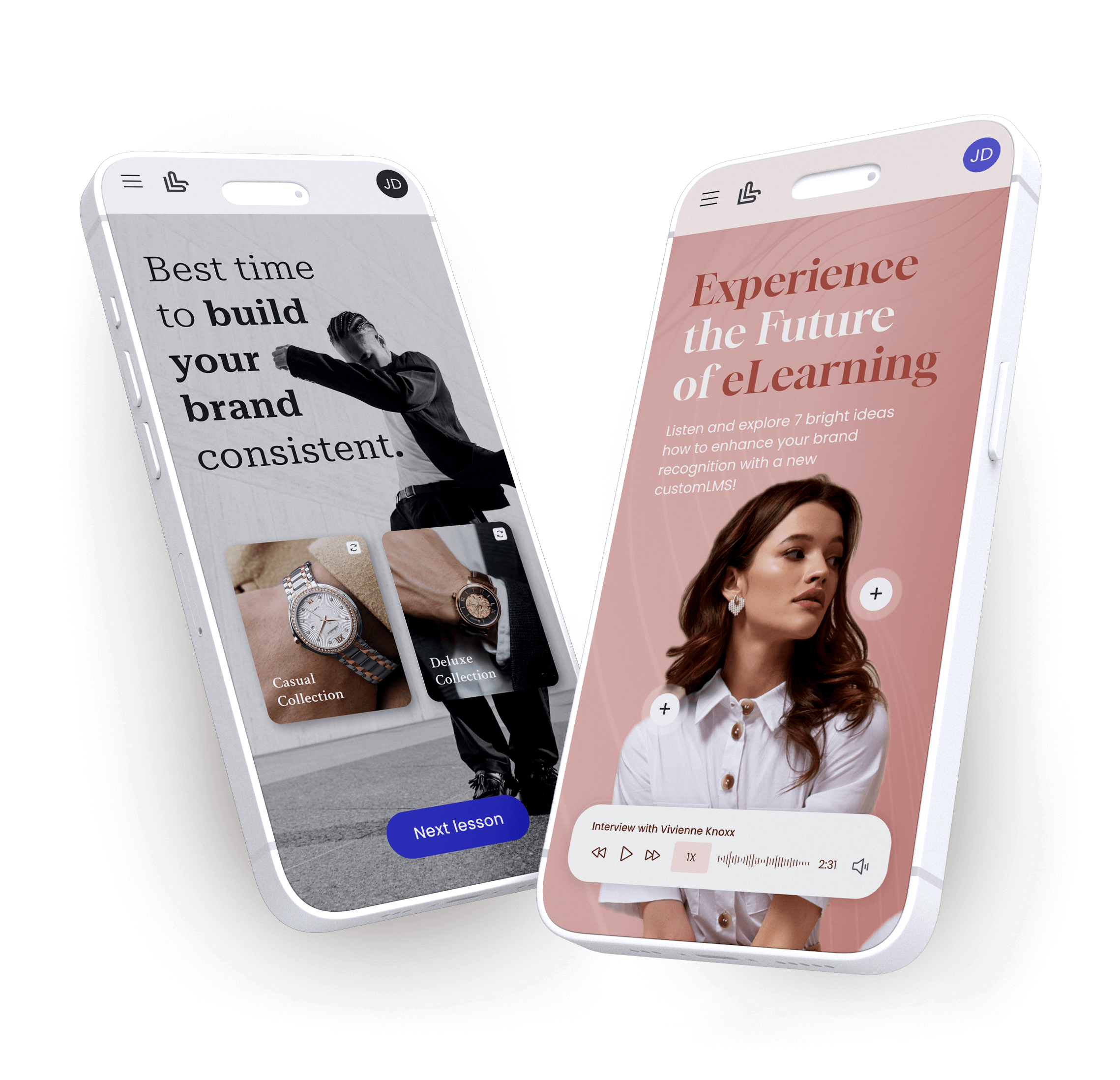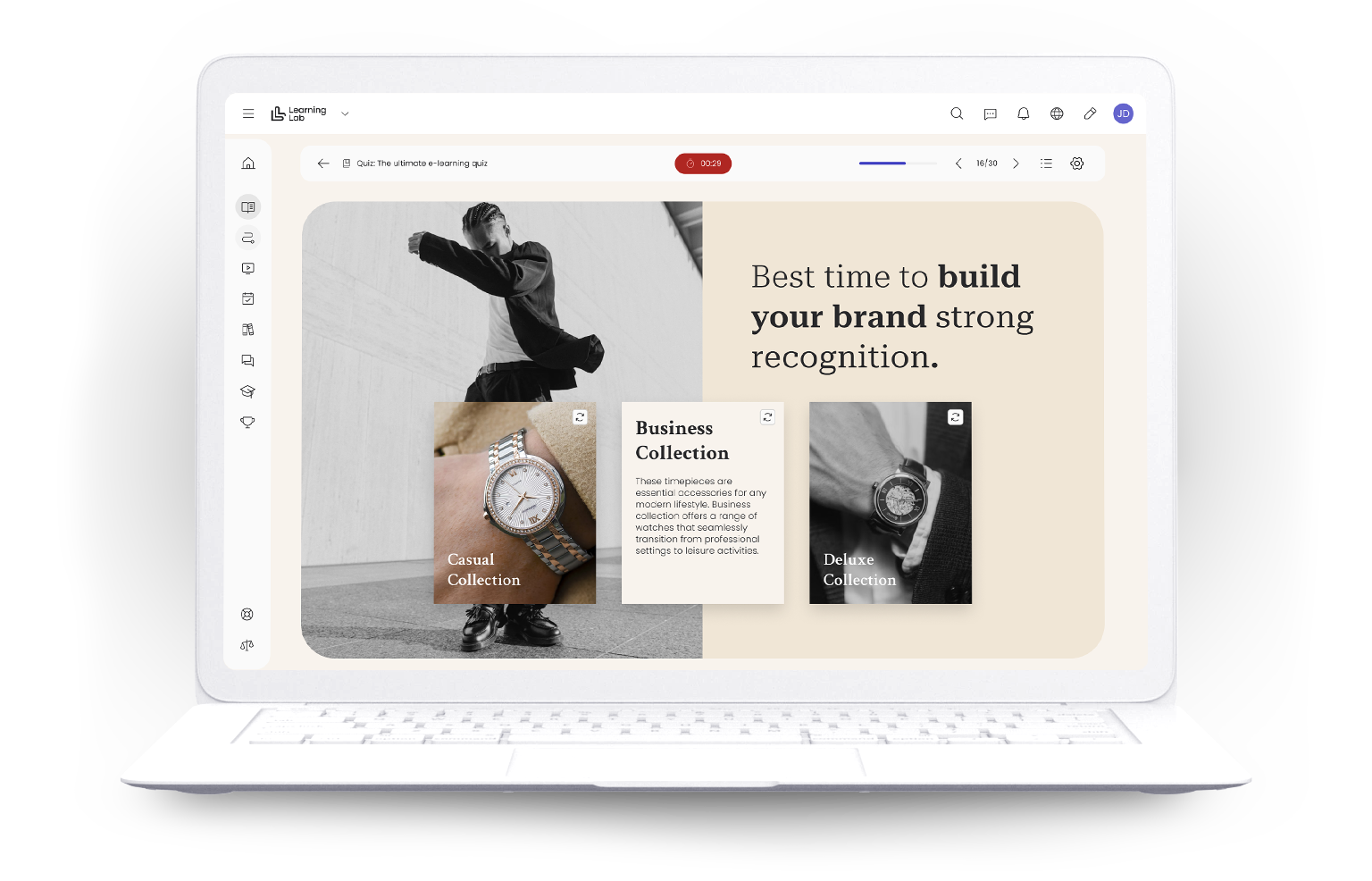How To Design Interactive courses in Your Retail Training
Interactivity is one of the biggest challenges that retail trainers face in e-learning today.
Research shows that the attention span of learners is decreasing, making it harder for retail employees to grasp essential concepts and improve their skills.
Therefore, it’s crucial to engage learners in digital retail training, and the key to achieving this is by making your e-learning course more interactive.
By enhancing interactivity, retail employees will be encouraged to actively participate and apply what they’ve learned. Here are five ways to create true interactivity in your retail training courses.
1. Promote group collaboration for your retail training
One of the most effective ways to enhance interactivity in retail e-learning is by encouraging employees to work together on training projects. Collaborative group work allows them to engage more deeply with the material, helping them understand key retail concepts through active participation.
Benefits of Group Collaboration in Retail Training:
Peer-to-peer learning: Retail employees often explain concepts to each other more clearly than a trainer can, making the learning experience more practical and relatable.
Critical thinking: Group collaboration encourages employees to share their ideas, debate solutions, and apply training to real-life retail scenarios.
Organised communication: Learners must structure their thoughts and present cohesive arguments, ensuring their ideas are understood and validated by their peers.
Critical analysis: Collaboration helps employees to analyse different perspectives, incorporate new ideas, and adjust their views as new information is introduced.
Facilitating Effective Group Collaboration:
Ensure tasks are challenging, engaging, and directly related to retail issues, encouraging team-based problem-solving.
Integrate social features such as chats or forums into your LMS to provide employees with a platform for interaction and discussion.
Transition your role from instructor to coach, supervising group dynamics to ensure teams collaborate effectively and work towards common goals.
By fostering group collaboration in retail e-learning, employees not only gain valuable knowledge but also develop the teamwork and communication skills needed for success in real-world retail environments.
2. Use branching scenarios in online retail training
Branching scenarios are a powerful tool for enhancing engagement and decision-making skills in online retail training.
By simulating real-world situations, they allow learners to make choices and experience the consequences of their actions, which is particularly valuable in a retail environment. Here’s how branching scenarios can improve retail training:
- Realistic decision-making: Learners can practice handling customer interactions, inventory management, or sales scenarios by choosing from multiple options and seeing the outcomes of their decisions.
- Improved problem-solving skills: By navigating through various scenarios, employees can develop critical thinking and adapt to different retail challenges.
- Increased engagement: Interactive scenarios help to keep learners engaged, making training more immersive and enjoyable.
- Tailored learning paths: Branching scenarios allow for personalised learning experiences, where employees can focus on areas they need to improve.
- Safe environment for mistakes: Employees can learn from their mistakes in a risk-free setting, helping them build confidence before applying these skills on the shop floor.
Incorporating branching scenarios into retail e-learning creates a more dynamic and practical learning experience that equips employees to handle real-life challenges effectively.
3. Incorporate interactive elements on each slide of your retail Training
An elearning course for retail will struggle to generate significant engagement without the use of interactive elements. You can introduce different elements to your retail training program, and it makes sense to use them on slides or pages. For example, you can add the following elements to your course:
Incorporating a variety of interactive tools in retail e-learning can significantly enhance engagement and knowledge retention. Here are some key techniques to make your retail training more dynamic:
Click and Learn: Allow employees to click on specific words, sentences, or images to reveal additional information, helping them explore key retail concepts at their own pace.
Infographics: Use visually appealing diagrams and charts to present information in an easy-to-understand format, perfect for showcasing sales processes or store layouts.
Videos: Create engaging videos that ask questions or offer extra information to reinforce key retail skills, such as customer service techniques or product knowledge.
Fill in the Blanks: Encourage learners to complete sentences by selecting the correct answers, helping them reinforce their understanding of retail terminology or procedures.
Drag and Drop: Use drag-and-drop exercises to improve knowledge retention, such as sorting product categories or arranging store displays in the correct order.
These interactive elements make retail training more engaging and ensure employees are actively involved in the learning process.
4. Gamify the retail learning experience
Introducing gamification into retail training can greatly enhance employee motivation and engagement by making the learning process more enjoyable and interactive.
Here are a few ways to gamify your retail learning experience:
Leaderboards: Encourage friendly competition by displaying a leaderboard where employees can see their progress and compare it with their colleagues.
Badges and Rewards: Offer digital badges or rewards for completing training modules or achieving high scores in quizzes, motivating employees to push for better performance.
Quizzes and Challenges: Integrate quizzes and time-based challenges to test knowledge retention and create a sense of achievement when employees successfully complete them.
Levels and Progression: Structure the training into levels, allowing learners to progress through increasingly difficult stages, mimicking the advancement of real-world retail skills.
Simulations and Scenarios: Use gamified simulations where employees can practice handling customer interactions or store management tasks, with immediate feedback on their decisions.
By gamifying the retail learning experience, you can make training more engaging, enjoyable, and effective for your employees.
5. Use interactive quizzes for Retail Training
Interactive quizzes are an excellent tool for enhancing engagement and reinforcing knowledge in retail training.
They provide immediate feedback and help employees retain critical information. Here’s how to effectively use interactive quizzes in retail training:
Knowledge Checks: Test employees' understanding of key retail concepts, such as product features, store policies, or customer service techniques, with quick quizzes after each module.
Scenario-Based Questions: Present real-world retail scenarios and ask employees to choose the best course of action, improving decision-making skills.
Timed Quizzes: Introduce timed quizzes to simulate high-pressure retail environments, helping employees improve their speed and accuracy in responding to customer needs.
Custom Feedback: Provide personalised feedback after each quiz to highlight areas of improvement and reinforce correct answers.
Progress Tracking: Allow employees to track their progress over time, showing them how their knowledge and skills are developing throughout the training.
Interactive quizzes keep employees engaged and ensure they can apply what they've learned to their day-to-day retail roles.
6. Interactive video for Retail Training Program
Incorporating interactive quizzes into training videos is a powerful way to enhance the learning experience in retail training programs. This combination keeps employees engaged while reinforcing key concepts as they watch. Here’s how to effectively use interactive quizzes in videos:
In-Video Knowledge Checks: Include short quizzes during key moments in the video to ensure employees understand important retail practices, such as sales techniques or customer service strategies.
Scenario-Based Interactions: Present real-life retail situations in the video and ask employees to choose how they would respond, reinforcing practical decision-making skills.
Instant Feedback: Provide immediate feedback after each quiz question to correct mistakes or confirm correct answers, helping employees retain the information more effectively.
Personalised Learning Paths: Based on quiz performance, direct employees to additional training resources or tailored video segments to strengthen their understanding of specific areas.
Engagement Tracking: Monitor quiz completion rates and performance to assess employee progress and adjust the training content as needed.
Using interactive quizzes within training videos makes the learning experience more immersive, ensuring employees stay engaged and apply their knowledge in real-world retail settings.
Conclusion
Incorporating interactive elements such as quizzes, collaborative projects, and gamification into retail training significantly enhances the learning experience.
These techniques actively engage employees, promote critical thinking, and ensure knowledge is applied to real-world retail scenarios.
By using tools like branching scenarios, interactive videos, and group collaboration, retail staff are better equipped to improve their skills and performance on the job.
Adopting a dynamic, interactive approach to e-learning in retail not only boosts employee engagement but also fosters long-term development and success within your team.





